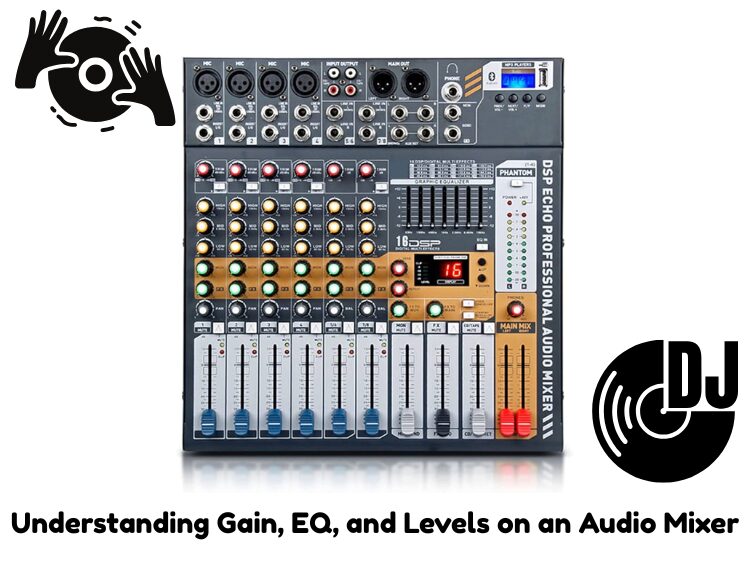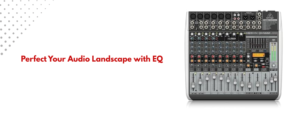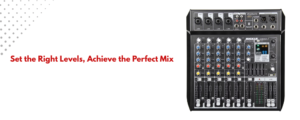An audio mixer is very important to know how to use correctly, whether running sound for a live show or recording in a studio. Gain, EQ (Equalisation), and Levels are the three main parts that directly affect the quality and clarity of the sound. Knowing how they work separately and together can make the difference between a finished mix and a jumbled soundscape.
What is Gain?
Gain is the very first step in what an audio mixer does to boost sound. It controls how strong the signal coming in is before the rest of the mixing works on it. Gain changes how much of the source signal gets into the channel, while volume changes how loud the signal is after handling it.
You can think of gain as the lens opening on a camera. To get too much light (distortion), make it too wide. To get too little light (a weak signal), make it too narrow. In the same way, setting the gain too high leads to cutting and distortion, while setting it too low creates a weak, noisy sound.
To set the gain right:
- The channel slider should be down to start.
- Ask the artist to play or sing at the volume they normally use.
- Raise the gain little by little until the level meter shows that the signal is strongest around 0 dB.
- Avoid going into the red, as this indicates overload.
If you’re still unfamiliar with how channel strips work, learn more about understanding audio mixer channels to get a better grasp.
Getting to Know EQ (Equalisation)
EQ changes the sound’s tone. It lets you boost or cut certain frequency bands to get rid of harsh tones, make the sound clearer, or make it less muddy. There are three types of EQ on most audio mixers: low, mid, and high. Some professional units may have adjustable EQs for even better control.
Here is a quick guide:
- Low frequencies (20 Hz to 250 Hz): Affect the sound of bass instruments and can make them warmer or less boomy.
- Mid frequencies (250 Hz to 4 kHz): Affect how clear vocals are and how present instruments are. Too much can sound boxy or harsh.
- High frequencies (4 kHz to 20 kHz): Add brightness and airiness. Overuse can cause hissing or harshness.
Use EQ in a subtle and deliberate way:
- When you can, cut instead of boosting.
- Get rid of sounds that are making things worse, like the mics’ low-end rumble.
- Only boost when a certain instrument or voice is missing.
How to Set Levels for a Well-Balanced Mix
In the final mix, levels tell you how loud each channel is. After the gain and EQ are set, channel faders are used to change the levels so that every part of the act can be heard clearly.
The goal is to be balanced:
- The lead voices should be clear and not too loud over the rest of the music.
- The bass and drums should work together to make a tight, full sound.
- The sound should be filled out by guitars, keyboards, and background voices that don’t clash.
If you want to improve your understanding of EQ, you can dive deeper into it by reading our beginner’s guide to using an audio mixer.
A good way to do it:
- Turn down all the faders to begin.
- Turn up the bass and drums to make a strong beat base.
- Add voices, making sure they are clear and noticeable.
- Gradually add other instruments and change the volume so that nothing is too quiet or too loud.
Keeping track of your output levels is important. For more tips on achieving optimal sound quality, check out our audio mixer setup guide.
To keep from cutting, you should also keep an eye on your main output levels. To avoid distortion when playing back or recording, keep the mix in a healthy range, usually rising between -3 and 0 dB.
How Levels, Gain, and EQ Work Together
All three of these parts work together. If you set one wrong, it can affect the others. For example, too much gain can make EQ changes sound too big and cause distortion. On the other hand, bad EQ can cause you to raise levels too much, which can make the mix noisy or cluttered.
The EQ can only work well if the gain stage is set correctly, and a neutral EQ lets you set better levels. Start at the top of the channel strip with gain and work your way down with EQ and the slider.
Conclusion
Gain, EQ, and levels are all important skills for any sound professional or audio lover to have. Each is very important for making a clean, skilled mix. You can improve the sound quality in both live and studio settings by learning how they work and how they affect each other. This will make sure that your audience hears every detail clearly and correctly.




